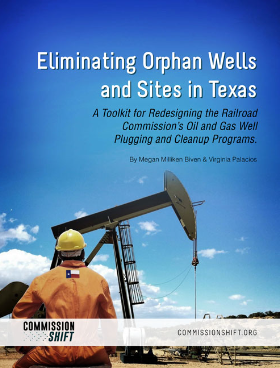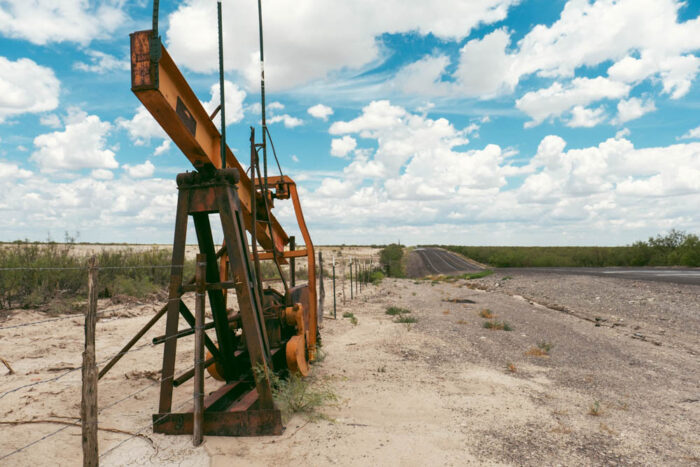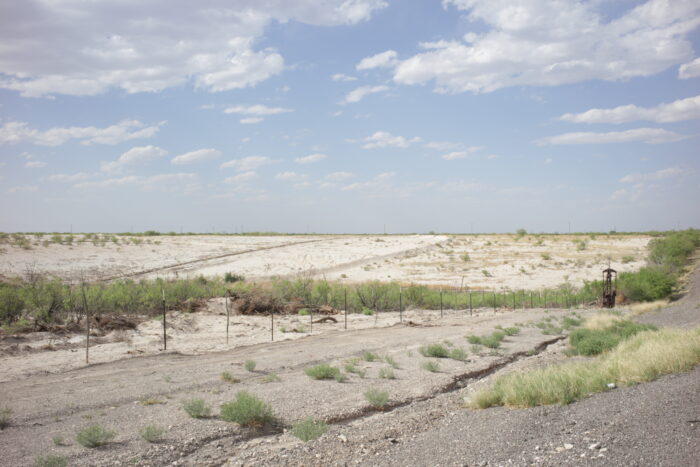Over the last century, the state of Texas has reaped billions of dollars by allowing companies to burrow into the floor of the Gulf of Mexico to extract oil and gas. Now, the General Land Office—the state agency tasked with protecting the vulnerable Texas shoreline and other natural resources—is eyeing carbon sequestration as the next industry to develop in the Gulf.
Angling for a share of $12 billion in federal funding for such projects under the 2021 Infrastructure Investment and Jobs Act, companies are competing to build carbon capture plants next to onshore oil wells, gas wells and other polluting facilities along the coast. At the same time, they are applying for offshore leases that will allow them to store that heat-trapping carbon dioxide deep beneath the seafloor.
Crucial to the effort are a stream of U.S. government grants, followed by generous tax credits for every ton of carbon stored.
In September 2021, Texas’s General Land Office, or GLO, awarded its first lease for carbon sequestration on 40,000 acres of state-owned land near Port Arthur to Talos Energy, a Houston-based oil and gas company. The oil giant Chevron has a 50 percent stake in the project, known as Bayou Bend, which if completed could be the nation’s first offshore carbon storage site.
Last month the GLO announced that it had awarded six more leases for offshore carbon storage that would generate $130 million in bonus payments for the state’s school fund. And in February, the Port of Corpus Christi, the nation’s largest port for oil exports and an economic engine for Texas, said it had received $16.4 million in federal funding to conduct a feasibility study for both onshore and offshore carbon storage projects. The research will be conducted with Texas A&M University, the University of Texas, Talos and Howard Energy Partners, a San Antonio gas company.
The GLO declined to provide details about the six offshore leases granted last month, from the location or size of the storage sites to the identities of the companies involved. Despite its August announcement that the projects had been greenlighted, the agency said the leases had not yet been formally “executed.”
The oil and gas industry maintains that carbon capture and storage technology, or CCS, can significantly reduce greenhouse gas emissions and hasten the nation’s progress toward net-zero status—the point at which the volume of heat-trapping gases released by power plants, oil refineries, factories and other major emitters would be equal to what is removed.
But environmentalists and scientists argue that CCS does not live up to those claims. So far, the technology has yet to be widely deployed and the results have been mixed, meaning that emissions continue to increase even as billion-dollar plants for carbon capture and sequestration are built out.
Relying on the oil and gas industry’s data, the nonprofit Institute for Energy Economics and Financial Analysis reported last September that 10 of 13 major CCS projects around the globe had failed or underperformed by wide margins. “It doesn’t work for as long as people claim it does, and there are significant uncertainties about how long it can be stored underground,” said Dennis Wamsted, an energy analyst at the institute.
Carbon capture technology essentially acts as a giant filter. When natural gas is burned at a power plant, most of the emissions typically flow directly into the atmosphere. But when a capture facility is attached to the power plant’s smokestacks, gases fed through the facility separate the carbon molecules from other pollutants through a series of chemical reactions.
The isolated carbon molecules can then be pressurized and compressed into a liquid that in theory is transported through a pipeline to a sequestration well, more or less modeled after an oil and gas drilling well. At this stage, the CO2 is sent back underground and trapped under layers of rock and sediment.
The Threat of Leaks and Explosions
Leakage is a major concern. In another study casting doubt on the viability of CCS, Italian researchers estimated that if storage wells leaked at a rate of 0.1 percent—– a likely scenario, based on what scientists have observed so far—an additional 25 gigatons of carbon would be added to the atmosphere by 2100.
Scientists, environmentalists and frontline communities also worry that the pipelines that transport pressurized carbon dioxide to storage wells could explode, putting nearby communities at risk: Three years ago in Satartia, Mississippi, dozens of people were hospitalized and hundreds evacuated after a CO2 pipeline ruptured. Emergency responders were impeded when the heavy concentration of carbon dioxide in the air prevented their vehicles from working.
Offshore injection projects like those proposed in the Gulf present other challenges. Sequestered carbon dioxide can move through geologic layers, particularly when older oil and gas wells already provide pathways. At an early CCS project in Norway, for example, researchers found that carbon stored beneath the seafloor began to migrate upward toward shallower rock layers, posing the possibility of leaks. Those injection wells were originally drilled in the late 1990s and have since been under constant monitoring and study.
Globally, there are no uniform guidelines for how long CCS wells need to be monitored, even though their reliability remains uncertain, Wamsted said.
Nonetheless, Texas has enthusiastically entered the fray. For the state, which has long channeled royalties from oil and gas leases into funding for public schools—some $3.7 billion has flowed into state coffers since the state began leasing offshore land for drilling in the 1960s—the potential dividends of undersea carbon storage are clear.
Onshore, CCS projects are proliferating as well, mainly around the petrochemical refineries on the Gulf Coast and the massive oil and gas drilling fields in the Permian Basin in West Texas. Oil executives say the existing pipeline infrastructure in the basin, coupled with the federal incentives, makes it a prime location for CCS, with tax credits flowing for every ton of carbon captured and injected underground.
Even King Ranch in south Texas, one of the largest cattle ranching operations in the country, may soon have a plant to suck up and store a greenhouse gas, in this case pulling the emissions from belching cows and manure—primarily methane—out of the ambient air.
Inevitably, the CCS projects announced to date raise questions about whether they will prop up the oil and gas industry for years to come rather than speed the effort to phase out fossil fuel production and consumption. Add in the persistent doubts about the capture technology and the potential leakage from storage wells, and critics ask whether the federal incentives will do more harm than good.
“What we are witnessing is a tremendous industry-led push to promote carbon capture and storage as its lifeline,” said Nikki Reisch, the director of the climate and energy program at the Center for International Environmental Law. “It is their get out of jail free card—it mainstreams the notion that we can continue using fossil fuels into the future.”
Wamsted points to the first and only CCS facility to operate so far at a U.S. power plant: the Petra Nova facility, which was tacked onto a 1970s-era coal plant at the W.A. Parish Generating Station outside Houston. The capture and storage operation received $190 million in funding from the federal Department of Energy and went online in late 2016.
“It claimed it was capturing 90 percent of the carbon, but our research showed that it was likely capturing 70 to 75 percent of the carbon coming through the project,” Wamsted said. “What you get down to is the fact that carbon capture equipment that has been run, tested and operated so far does not operate nearly as well as proponents say.”
And the CCS facility required its own natural gas generator to operate—emitting methane, an even more potent heat-absorbing gas that was not captured at all.
In another environment\al paradox, Petra Nova’s captured carbon was used for “enhanced oil recovery,” a technique in which pressurized CO2 is pumped into an existing oil or gas well to squeeze out the last of the fuel deposits. After the CCS facility was mothballed in 2020, a spokesperson for NRG Energy, which backed the project, was quoted as attributing the decision to a nosedive in oil prices.
Locally, community advocates pushed for the Parish coal plant to be shut down altogether because of concerns about climate change and air quality. Instead, after the infusion of $1 billion in investment by private companies and the federal government, the coal plant is likely to remain open for years.
Area residents are suffering the consequences. A 2018 study by Rice University researchers linked air pollution from the coal plant, including sulfur dioxide and ozone emissions, to hundreds of excess deaths and cases of asthma and other respiratory illnesses in the region.
“These are communities that are already putting up with chronic and neglected air pollution problems,” said Alexander Spike, a climate justice advocate for the group Air Alliance Houston. “Industry is not completely up-front about what carbon capture means for communities, so these communities are getting the short end of the stick at the profit of industry.”
Advocates of the technology counter that CCS is simply one way forward in the complex and daunting task of reducing greenhouse gas emissions to save the planet. “This absolutely helps solve the problem, as a tool in the kit,” said Susan Hovorka, a research scientist at the Bureau of Economic Geology at the University of Texas and the principal investigator for the university’s Gulf Coast Carbon Center. “Now is not the time to say we throw out the tool.”
A Bid for State “Primacy”
That Texas came to own the oil-rich land beneath the seafloor is, in some ways, a quirk of history. In 1836, when Sam Houston is said to have drawn the boundaries of the independent Republic of Texas, he extended its coastal border 10.3 miles outward, following Spanish colonial precedent. Texas entered the Union nine years later, and for nearly a century afterward, the U.S. government paid no mind to the boundary, allowing the state to do what it pleased.
But when oil began flowing from those state-owned lands, federal officials began to take an interest. States like Louisiana and Mississippi only claimed land rights 3.5 miles from the shore, and any royalties from oil and gas recovered past that boundary were collected by the federal government.
From the 1940s until 1953, the states and the federal government battled for ownership of submerged lands: Three separate lawsuits wound their way to the Supreme Court, and the issue was debated in Congress.
Today, although Texas still owns all of the land within 10.3 miles of its coast, it does not have sole authority to greenlight carbon sequestration wells in the Gulf of Mexico. Classified as “Class VI wells,” all such sites are currently regulated by the federal Environmental Protection Agency.
But Texas and Louisiana, another state that is ramping up CCS projects, have asked the EPA for “primacy” in regard to the wells, which would allow state agencies to grant permits for and oversee them.
Critics say that if the EPA were to grant states primacy, removing the federal hurdles, sequestration wells would acquire permits for underwater carbon storage at a quicker pace. States already permit and regulate other types of injection wells on land, known as Class II wells, which are used for enhanced oil recovery, said Paige Powell, a policy expert at Commission Shift, a watchdog group that seeks reforms in oil and gas oversight in Texas.
In Texas, securing primacy would mean that the EPA handed over authority to the state Railroad Commission, which has a spotty track record on enforcing existing oil and gas regulations. “When you look at Class II injection wells, we see induced seismicity and sinkholes,” Powell said. “We’re seeing blowouts that are like geysers.”
“We’ve been trying to make the case that the Railroad Commission is mismanaging its Class II program, and the EPA should not give them any more authority,” she added.
The commission is currently responsible for cleaning up and maintaining thousands of abandoned oil and gas wells that bankrupt companies have left behind all over the state. In the future, the state may also be on the hook for abandoned CCS projects: Its lease agreement for the Bayou Bend project, for example, says the GLO will take over management of carbon storage wells if the investors decide to walk away from the venture.
“Our lessees are required to follow all state and federal laws,” the GLO said in a written statement, adding that the EPA’s permitting process “includes evaluation and planned mitigation of potential environmental risks and continuous monitoring during the injection phase of the project.”
At the same time, Texas lawmakers have sought to deflect corporate responsibility for any problems arising at sequestration wells from the oil and gas industry. House Bill 4557, introduced last spring in the hope of encouraging investment in CCS projects, would have limited the types of civil suits residents could bring against companies in the event of a disaster. The bill died in committee, but Powell says it is likely that discussions will be revived in two years when the legislature next meets; it convenes for five months every other year.
Given the momentum gathering for CCS projects in Texas, environmental advocates fear the consequences of ceding regulatory control to the state.
“The world standard for carbon sequestration is 99 percent of the CO2 stored for a thousand years,” Powell said. “That means we need to monitor it for a thousand years. But there are major concerns that companies are going to be able to hand over their liability for carbon injection wells to the state after 10 or 50 years.”




